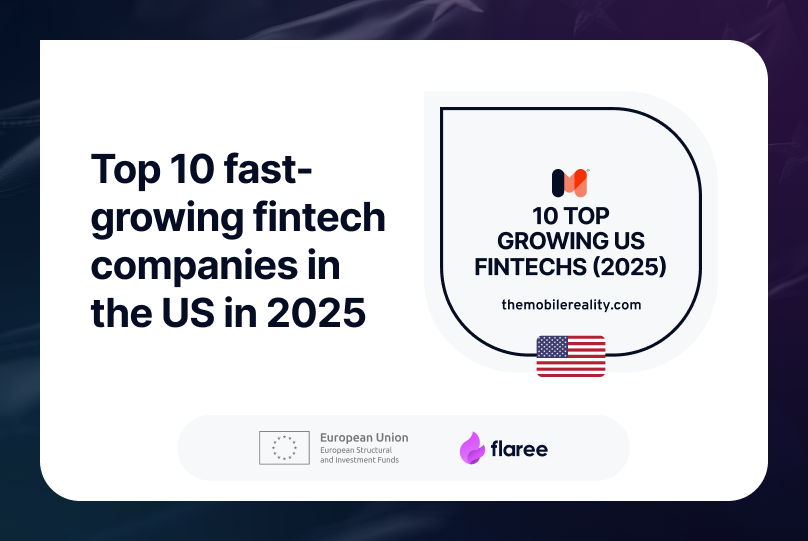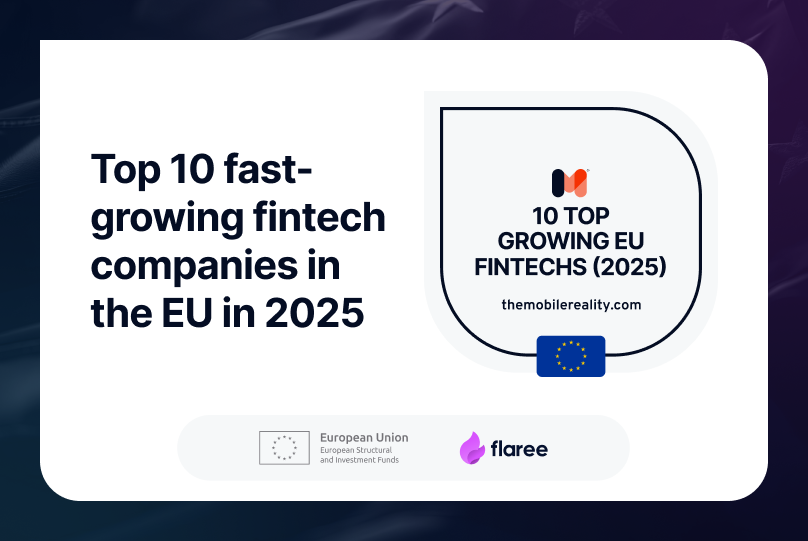Introduction
Software development stands out as a quintessential cornerstone in the rapidly evolving world of technology, shaping the digital ecosystem. This intricate process isn't just about writing lines of code; it's about creating solutions tailored to meet specific needs while ensuring efficiency, scalability, and robustness. But to embark on this journey, it's crucial first to set the right course. At the heart of this preliminary phase is the selection of an appropriate development methodology and astute mapping out priorities. The choices made at this juncture can echo throughout the project's lifecycle, often determining its success or failure.
But here's the challenge: the realm of software development is replete with numerous models and methodologies. For those just dipping their toes in, or even for seasoned professionals navigating the ever-evolving landscape, the waters can get murky. From terms like "Agile" and "Waterfall" to "Scrum" and "Kanban", the list is extensive and at times, overwhelming. Moreover, with the plethora of information available online, a significant portion of which contradicts another, it becomes all the more challenging to discern between what's what.
So, is there a difference between a software development model and a methodology? If so, how stark is it? How can one select the most suited approach for a particular project, especially when the stakes are high?
This article seeks to demystify these crucial questions. As we journey through the nuances of the most prevalent software development models and methodologies, we'll shed light on their distinctive features, applications, and the scenarios where they shine brightest. By the end of this guide, not only will you have a clearer understanding of the available options, but you'll also be equipped to make informed decisions that can significantly impact the trajectory of your software projects.
Stages of the software development life cycle
The life of software isn't just about its existence after being launched; it's a journey that begins with an idea and continues long after its deployment, encompassing a series of systematic stages. These stages ensure the software is built with precision, meets its intended purpose, and remains relevant and functional over time. While the names and subdivisions of these stages may vary based on the development model in question, they predominantly revolve around preparation, design, creation, and support.
To provide a more tangible understanding, let's dive into these SLDC stages by tracing the life cycle of an online store – an entity that has become indispensable in the modern e-commerce-driven era.
Preparation:
Scenario: Ivan, sensing the booming trend in online shopping, aspires to launch his online bookstore. But before taking the plunge, he embarks on comprehensive research.
Action: Ivan examines existing online bookstores, gathering data on their traffic, user experience, features, and overall functionality. This stage aids Ivan in identifying gaps in the market and determining a unique value proposition for his store.
Designing:
Scenario: With a clearer vision in mind, Ivan collaborates with a reputable software development firm to breathe life into his idea.
Action: Together, they conceptualize the architecture of the online store, focusing on aspects like user navigation, product categorization, and the overall aesthetic appeal. Mockups and wireframes are created to visualize the end product, ensuring alignment with Ivan's vision.
Creation:
Scenario: It's time to get the ball rolling. A contract, which clearly defines the scope of work, deliverables, and timelines, is inked between Ivan and the development firm.
Action: The developers delve into coding, constructing the back-end infrastructure and crafting the front-end interface. Concurrently, graphic designers add a layer of visual finesse, while comprehensive documentation is prepared to ensure smooth operation and future modifications.
Support:
Scenario: The online bookstore is now ready for its debut. But as with any software, the journey doesn't end with its launch.
Action: Users start flocking to the site upon successful testing and deployment on live servers. As they navigate and make purchases, some might encounter issues or bugs. A dedicated support team stands by, addressing user queries and rectifying glitches, ensuring a seamless shopping experience.
While these four development stages provide a simplified view of the SDLC, software development often involves a more detailed breakdown of phases in practice. A more comprehensive list might look something like this:
Requirement Analysis: The initial phase is where the project's requirements are gathered, analyzed, and documented.
Planning Phase: Based on the requirements, a plan is devised outlining the resources, timeline, and cost estimates for the project.
Design Phase: In this phase, the software's architecture is determined. This includes both high-level system architecture and low-level component design.
Implementation Phase(or Coding): Actual coding of the software takes place in this phase. The system is built in small programmable units and integrated to function as a whole.
Testing Phase: One of the phases where software is tested to identify any defects or discrepancies from the original requirements. Quality software is a key to well-performed application.
Deployment Phase: Once the software is deemed ready and has passed the testing phase, it is deployed to the target environment and made available to end-users.
Maintenance and Support: Post-deployment, the software might require regular updates and fixes as users start interacting with it. This phase ensures the software remains functional and up-to-date.
Retirement or Decommissioning: Eventually, the software might become obsolete or be replaced by a newer version. In such cases, it needs to be safely retired and decommissioned.
While the list above provides a more detailed breakdown of the stages of SDLC, it's worth noting that different methodologies or approaches to software development might have variations in the naming or number of stages.
Now, you might wonder, where do models of software development and methodologies fit into this narrative? Simply put, the SDLC models (software development life cycle models) provide a structured blueprint, defining which stages the software will undergo and the intricacies of each stage of application creation. On the other hand, the methodology is the backbone of this process, offering a toolkit of methods, principles, and best practices that streamline the development journey, enhancing its efficiency and efficacy.
Basic software development models
In the intricate universe of software development, the journey from conception to completion is navigated using various models. These models offer distinct roadmaps, shaping how software progresses from its initial idea phase to its final product stage. Let's explore some fundamental software development models, paying particular attention to the five most prevalent ones.
Code and Fix:
Description: As rudimentary as it sounds, this model involves coding straight away without much prior planning and then fixing the errors as they come up. It's considered less structured and is usually reserved for smaller projects or prototypes.
Waterfall Model:
Description: Often visualized as a cascading waterfall, this model is linear and sequential. Each phase of development flows into the next, making it essential that one phase is completed before the next begins.
V-model (Validation and Verification Model):
Description: In this model, each development phases corresponds to a testing phase, forming a V shape. It emphasizes the importance of validation and verification, ensuring each development stage has an associated testing phase.
Incremental Model:
Description: As the name suggests, the software is developed and delivered in increments or parts. After the initial software version is developed, subsequent versions are prepared with additional features until the full software is completed.
Iterative Model:
Description: Here, the software is developed in iterations or cycles. After each iteration, the software is improved based on feedback until it meets the desired requirements.
Spiral Model:
Description: This model blends the features of the Waterfall and Iterative models. It focuses on risk assessment and early identification of issues, with the project spiraling through iterative phases and constant refinements based on feedback.
Chaos Model:
Description: This adaptive model posits that while the requirements for larger software systems might begin in chaos, they eventually stabilize and become clearer as developers work on them.
Prototype Model:
Description: Before the final software is developed, a prototype or preliminary version is created to get user feedback. Based on this feedback, refinements are made, leading to the creation of the final product.
In the next part of this article, we will focus on the five most popular software development models:
Waterfall Model: Its structured, phase-by-phase approach makes it ideal for projects with well-defined requirements and minimal changes. Each stage must be completed before moving on to the next, ensuring a systematic progression.
V-model: This model underscores the significance of testing. Pairing each development phase with a testing phase ensures a rigorous check on quality and functionality at every step.
Incremental Model: Best suited for projects where parts of the system need to be delivered quickly. By breaking the project into smaller phases and manageable parts, it ensures faster delivery and better adaptability to changes.
Iterative Model: With an emphasis on feedback and constant refinement, this model allows for flexibility and adaptability, making it apt for projects with evolving requirements.
Spiral Model: By combining the Waterfall's linearity and the Iterative models' flexibility, the Spiral model offers a balanced approach. Its focus on risk analysis makes it ideal for complex and large-scale projects.
In conclusion, selecting the right model among different software development process models hinges on the nature and requirements of the project, available resources, timeline, and desired outcomes. Understanding the nuances of these models empowers developers and project managers to make informed decisions, paving the way for successful software development endeavors.
Waterfall (cascade model, or "waterfall")
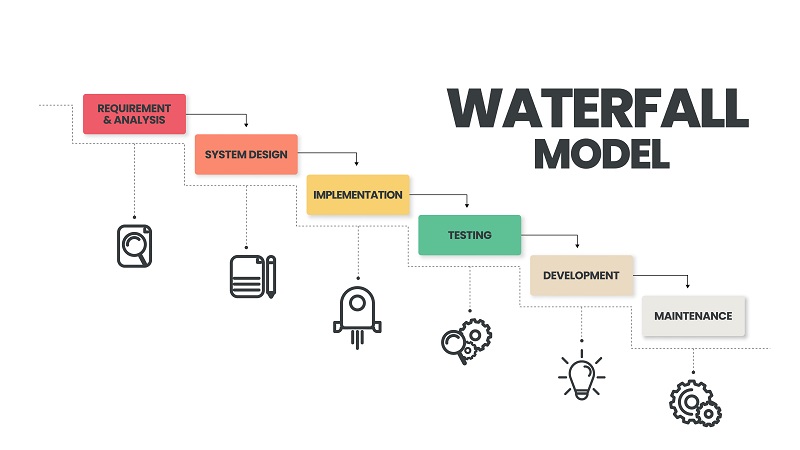
The Waterfall model of the software development life cycle, often depicted as a cascading waterfall, is one of the most classical approaches to SDLC. It is characterized by a linear and sequential flow, where each stage commences only after the preceding one concludes. Its inception traces back to the 1970s, marking it as one of the pioneering software development methodologies. The name 'Waterfall' metaphorically captures its essence – just as a waterfall flows step by step down the tiers, the development process too cascades from one stage to the next.
Advantages of the Waterfall Model
Predictability and Control: Given its structured approach, it provides a clear roadmap of the entire development journey. Stakeholders can easily track the project's progress and anticipate the next stages.
Defined Costs and Schedule: Budgeting becomes straightforward since every phase is mapped out at the onset. Stakeholders have clarity on the expected costs and timelines, leading to fewer surprises.
Less Dependency on Expert Testers: Owing to its emphasis on comprehensive documentation, even testers without profound technical expertise can effectively validate the software, relying on the extensive details available to them.
Disadvantages of the Waterfall Model
Late Testing Phase: Testing is relegated to the tail-end of the development process. Consequently, any discrepancies or issues identified at this juncture can lead to substantial rework, escalating time and costs.
Delayed Feedback: Since the final product is only revealed towards the end, stakeholders and clients don't get an opportunity for feedback until it's nearly completion. This can lead to potential misalignments with the client's vision or market needs.
Extensive Documentation: While thorough documentation can be an asset, it can also become cumbersome. It demands substantial time and effort, and any changes to the initial plans can lead to cascading updates, further stalling the development process.
Ideal Scenarios for the Waterfall Model
The Waterfall model is particularly apt for projects with well-defined requirements and unlikely to change. Industries such as medical and aerospace, with a vast repository of pre-established documents like SNIPS and specifications, can leverage this model effectively. A deviation from set standards can have dire consequences in these sectors, making the Waterfall's rigorous, phase-by-phase approach fitting.
A Key to Successful Waterfall Implementation
The essence of the Waterfall model lies in meticulous planning. The emphasis should be on crafting detailed and accurate development requirements. This precision ensures that any discrepancies identified during testing have a minimal ripple effect, impacting only specific facets of the product rather than triggering a complete overhaul.
In sum, while the Waterfall model offers several benefits, its suitability hinges on the nature of the project. The Waterfall model can be a potent tool in the software development arsenal for projects with fixed requirements and ample time for thorough planning.
On the other hand, according to the ZIPPIA.com waterfall projects, success rate is as follows:

V-shaped Model (Development through Testing)

The V model software development, aptly named due to its V-like structure, represents an extension and enhancement of the classic Waterfall model. This model adds an essential layer of validation to each phase of development, ensuring a parallel testing process. Originating in the 1980s, it underscores the importance of validation and verification throughout development.
Underlying Principle: In the V-shaped model, for every development stage on the ascending leg of the "V," there's a corresponding validation or testing phase on the descending one. This linkage ensures that validation is concurrently planned and eventually executed as development progresses, ensuring quality at every juncture.
Advantages of the V-shaped Model
Early Error Detection: By emphasizing testing in tandem with development, the model facilitates the early discovery of discrepancies, reducing the potential for bigger issues downstream.
Clear Milestones: Both the development and testing processes have clearly defined milestones. This offers transparency and makes project management more straightforward.
Enhanced Quality: Given the inherent focus on validation, the resulting software typically boasts higher quality with minimized architectural errors.
Disadvantages of the V-shaped Model
Rigidity in Changes: Similar to the Waterfall model, the V-shaped model isn't particularly adaptive. If an error or requirement change surfaces during the later stages, backtracking becomes cumbersome and costly.
Late Functional Software: Since the model necessitates the completion of all stages for fully functional software, stakeholders and clients have to wait until the end to see the final product.
High Initial Investment: The parallel development and testing structure might require considerable resources upfront, especially in terms of crafting detailed testing criteria for every development phase.
Ideal Applications for the V-shaped Model
Given its emphasis on reliability and rigorous validation, the V-model shines in scenarios where the margin for error is razor-thin, and the consequences of mistakes can be severe. This makes it particularly suitable for critical systems such as:
Automotive Safety: As in the development of car airbag systems, a malfunction could be life-threatening.
Medical Systems: Patient monitoring tools in hospitals or clinics must operate flawlessly to ensure patient safety.
Aerospace Applications: For projects like flight control systems, where a single error can have catastrophic results.
In conclusion, the V-shaped model, with its emphasis on concurrent validation, offers a robust framework for projects where precision and reliability are paramount. While it may not offer the flexibility of some contemporary methodologies, its systematic approach ensures a high-quality output, especially when the stakes are high.
Incremental Model (Incremental Development): A Segment-by-Segment Approach
The Incremental model, inspired by the term' increment,' signifies progress in segments. The roots of this approach can be traced back to the 1930s, making it one of the older methodologies, yet its relevance remains. Imagine constructing a social network – it's similar to building a house, brick by brick.
An Illustrative Example: Imagine a tech entrepreneur who aspires to launch a cutting-edge social network. Instead of plunging headlong into full development, the tech team suggests starting with foundational features: profile creation and basic messaging. This "minimum viable product" (MVP) is introduced to the market to gauge user reception.
If the feedback is positive and there's promising traction, the development continues. Subsequent increments might involve photo uploads, document sharing, music streaming, and other functions. With each added feature, the platform moves closer to the envisioned comprehensive social hub laid out in the initial specifications.
Advantages of the Incremental Model
Phased Financial Commitment: The incremental approach reduces initial capital outlay. Clients fund foundational features, release them to the market, and then decide on further investment based on tangible feedback.
Rapid Feedback Loop: Launching in increments allows for real-time user feedback. This ensures the product's evolution aligns with actual user needs, reducing the risk of a market mismatch.
Cost-Effective Error Rectification: In the Incremental model, if a flaw is detected in a particular segment, its rectification is less resource-intensive compared to monolithic models like Waterfall or V-shaped.
Disadvantages of the Incremental Model
Inconsistent Interface: With different teams handling various increments, there's a risk of inconsistent user interfaces or experiences. It's crucial to establish clear guidelines and maintain a cohesive vision across all segments.
Potential for Feature Creep: Developers might get sidetracked by minor enhancements, delaying the realization of core functionalities. Vigilant project management is necessary to keep the focus on primary features.
Dependence on Continuous Feedback: If the feedback mechanism isn't efficient, it might lead to repeated modifications, prolonging the project's completion.
When is the Incremental Model Most Suitable?
The Incremental model is particularly apt for projects that:
Have well-defined primary software requirements from the outset.
Seek to make a quick market entry, with the intent to evolve based on user feedback.
Operate in fast-paced industries where user preferences change rapidly, requiring agile adaptability.
In summation, the Incremental model offers a pragmatic approach to software development. Progressing in stages and incorporating user feedback allows for a more adaptable and market-responsive product evolution, provided the process is adeptly managed.
Iterative Model
The Iterative model is like the sculpting of a masterpiece. The sculptor doesn't necessarily begin with a clear picture of the final piece but incrementally chisels assesses, and refines until the artwork emerges in its splendid form. In software development, the Iterative model follows a similar modus operandi: gradual refinement based on ongoing evaluation and feedback.
An Illustrative Journey: Consider the development of a new messenger app. The foundational version may merely allow one-on-one chats. Once released in the app store, its popularity gives the developer insights into its potential. Capitalizing on its traction, the development team iteratively adds features like video calls, photo sharing, and voice notes, molding the app according to user feedback and evolving market dynamics.
Advantages of the Iterative Model:
Flexible Feedback Integration: The cyclical nature of development allows constant feedback incorporation. Every iteration can cater to evolving user needs, market shifts, or technological advancements.
Early Market Entry: Even with basic functionality, the product can be released to the market, giving users a taste and generating early interest.
Reduced Initial Risk: With smaller goals set for each iteration, developers can concentrate on perfecting specific features, thereby reducing the risk of overarching errors.
Disadvantages of the Iterative Model:
Scalability Challenges: Initial decisions about infrastructure, such as databases or servers, might prove inadequate as the application grows in scope. This could necessitate substantial rewriting or restructuring later on.
Budgetary and Temporal Ambiguity: The absence of a clear endpoint can lead to budget overruns or extend project timelines. Clients and stakeholders must brace for some unpredictability.
Complex Maintenance: As iterations compound, maintaining consistent code quality and documentation can become challenging.
When to Opt for the Iterative Model?
This model shines brightest when:
The software development project vision isn't set in stone and is expected to evolve over time.
There's an emphasis on learning from real-world usage and adapting accordingly.
The project is sizable or novel, with requirements that might only become clear as development progresses.
In essence, the Iterative model champions adaptability. Launching preliminary versions and enhancing them cyclically marries the core principles of innovation with the practicality of real-world feedback, making it especially relevant for dynamic markets and visionary products.
What are the differences between incremental and iterative software development models?
The Incremental and Iterative software development models are both approaches that break down the software development process into smaller chunks or cycles. However, their objectives, focus, and how these cycles are carried out differ. Here's a detailed comparison:
Focus:
Incremental Model: The primary focus is on breaking down the software development into manageable portions or "increments." Each increment typically adds a set of functionalities to the previous increment, leading to fully functional software at the end.
Iterative Model: The main idea is to refine the software through repeated iterations. In this model, a simple version of the software is built initially, and in each subsequent iteration, it's improved and refined based on feedback and evaluation.
Requirements:
Incremental Model: Usually, the requirements are well-understood and defined from the outset. Each increment focuses on a specific subset of these requirements.
Iterative Model: Requirements can evolve and become clearer with each iteration. Feedback can influence subsequent iterations as developers build and users test the software.
Product Release:
Incremental Model: Each increment results in a usable portion of the software. When combined, these portions give you the complete system.
Iterative Model: The initial release might be a very basic software version. With each iteration, it gets refined and closer to the final product.
Feedback Cycle:
Incremental Model: Feedback is typically obtained after each increment, but mostly about the functionalities added in that increment.
Iterative Model: Feedback is continuous and is about the whole product. It informs the next iteration, which could involve refining any aspect of the software, not just the newly added features.
Risk:
Incremental Model: Risk is generally distributed across increments. Since each increment is smaller in scope, issues in one increment might not heavily impact others.
Iterative Model: There's a continuous risk assessment, as the software is continually evaluated and refined. Mistakes or misconceptions from early iterations might get propagated if not caught and fixed.
End Product:
Incremental Model: The final product is essentially the sum of all increments. Each increment builds upon the previous one until the software is complete.
Iterative Model: The final product is a refined version that has undergone multiple iterations. It's not just an accumulation of features but an evolution based on feedback and learning from each iteration.
In practice, many modern software development projects use a combination of both Incremental and Iterative approaches, often embodied in Agile methodologies like Scrum. This hybrid approach leverages the strengths of both models to deliver products that meet user needs and adapt to changing requirements.
Spiral Model
The Spiral Software Development Model is a sophisticated approach that combines iterative development with the systematic, controlled aspects of the Waterfall Model. This model places significant emphasis on risk assessment and ensures that the project consistently evaluates risks at each phase. Dr. Barry Boehm introduced this model in 1986, aiming to incorporate flexibility in software design and development.
To illustrate how the Spiral Model functions, let's delve into the development of a "Smart Home" system.
The customer envisions a comprehensive system that facilitates everyday chores through phone commands. Starting with the kettle control, the project follows a structured methodology: gathering requirements, analyzing market competitors, devising system architecture, determining the implementation strategy, executing the development, performing tests, and finally releasing the product for usage.
Post the kettle control success. The team contemplates expanding to TV control. Here, the cycle recommences - from conceptualization to product release. However, the complexity escalates since it's an enhancement built upon the previous iteration.
When exploring the feasibility of integrating refrigerator control, the customer and team recognize the complications of incorporating a Wi-Fi module into the fridge. Recognizing the challenges and potential lack of manufacturer collaboration, the risks outweigh the benefits. The informed decision is to refine existing functionalities and pave a clearer roadmap for the Smart Home system's evolution.
At its core, the Spiral Model resembles the Incremental approach. However, it differentiates itself with a pronounced emphasis on risk evaluation at each phase. With each spiral, the complexity and understanding of the project amplify, making it apt for intricate projects demanding continuous refinement and evaluation.
Advantages of the spiral model:
Risk Management: It prioritizes regular risk assessments, identifying and addressing potential problems promptly.
Flexibility: It easily accommodates changes at any stage, adapting to evolving requirements.
Customer Feedback: The iterative nature allows regular customer feedback, ensuring the product meets user expectations.
Disadvantages of the spiral model:
Complexity: Due to its multiple phases and continuous evaluations, the model can become intricate, especially for small projects.
Initial Stage Looping: There's a possibility to remain entangled in refining the primary version endlessly, preventing progression to advanced stages.
Cost and Time: Given its comprehensive nature, the model might require more resources in terms of time and budget.
Emerging from the foundational principles of the Spiral Model, Agile Models were conceived. While Agile isn't strictly a model or a methodology, it's an evolutionary approach to software development, promoting collaboration, adaptability, and customer-centricity.
Which software development model that we analyzed in the previous sections is able to cut costs the most?
From the software development models we discussed, the Incremental model is most often associated with the potential to cut costs effectively. Here's why:
Initial Lower Costs: Unlike other models where the entire system is developed and delivered at once, the Incremental model focuses on creating and delivering parts of the system in increments. This means you can begin with a smaller budget focused on the most crucial components.
Immediate Return on Investment (ROI): Since parts of the system or product are released in phases, there's potential for an earlier ROI. Some increments can be monetized, providing revenue that can finance subsequent phases.
Feedback Reduces Waste: By releasing in increments, developers can get feedback early in the process. This feedback can guide the next increments, ensuring that only features that offer value are developed. This approach can prevent the waste of resources on unwanted or unnecessary functionalities.
Errors are Less Costly: Mistakes made during one increment's development can be identified and corrected before the next increment starts. This iterative feedback loop can prevent expensive, large-scale overhauls at later stages.
Flexibility in Prioritization: Developers and stakeholders can prioritize certain increments over others based on market demand, feasibility, and other factors. This flexibility ensures that resources are spent most efficiently.
However, it's essential to note that while the Incremental model can offer cost-saving advantages, the actual savings will vary based on how well the model is implemented, the nature of the project, and external factors like market conditions and user feedback.
What is Agile?
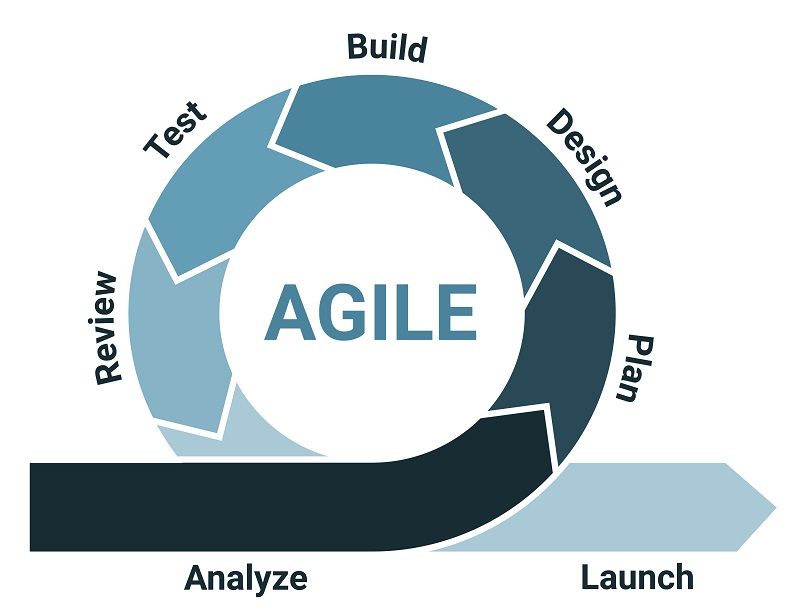
Agile, derived from the English term meaning "flexible" or "nimble," represents a paradigm shift from traditional, linear software development methodologies to a more collaborative and adaptive approach. Unlike traditional methods that emphasize a rigid sequence of steps, Agile emphasizes flexibility, collaboration, customer feedback, and adaptability throughout the lifecycle of a project.
The essence of Agile is captured in the Agile Manifesto, formulated in 2001 by seventeen software developers. The manifesto promotes:
Individuals and Interactions over processes and tools.
Working Software over comprehensive documentation.
Customer Collaboration over contract negotiation.
Responding to Change over following a plan.
According to GITNUX MARKET DATA:
Approximately 60% of software development companies use Agile methodologies for their projects.
The Agile Model is not a single methodology but rather an umbrella term encompassing various practices, frameworks, and methodologies that uphold the principles of the Agile Manifesto. Agile Models include:
Extreme Programming (XP): Focuses on technical excellence and close collaboration between developers and customer representatives. Extreme Programming emphasizes pair programming, continuous integration, and regular feedback.
Lean Software Development: Derived from Lean manufacturing, this agile method emphasizes reducing waste, amplifying learning, making decisions as late as possible, and delivering as fast as possible.
Scrum: A framework that divides development into short, fixed-length iterations called sprints. It emphasizes collaboration, adaptability, and delivering a potentially shippable product increment with every sprint.
Feature-driven Development (FDD): Organizes software development around making and verifying distinct features prioritized by their value to the client.
Test-driven Development (TDD): A technique where developers first write tests for a new feature before writing the code for the feature itself. This ensures the software functions as expected.
Cleanroom Software Engineering: Emphasizes a rigorous, specification-based approach and statistical quality control carried out by the engineering team.
Interactive-Incremental Development Method (Open UP): An iterative framework that encourages incremental development and stakeholder participation throughout the project.
Microsoft Solutions Framework (MSF): A set of principles, models, and best practices from Microsoft that's aimed at delivering solutions that satisfy customer needs.
Dynamic Systems Development Method (DSDM): Prioritizes business needs and delivers the project in a rapid, iterative, and incremental manner.
Kanban: Inspired by the Toyota Production System, it emphasizes visualizing the work process and limiting work in progress to improve efficiency.
It's worth noting that Agile methodologies are not mutually exclusive. Many organizations combine elements from different agile software development methodologies, adapting them to best suit their unique requirements and organizational culture. The key to the Agile Model's success is its focus on delivering value quickly and its adaptability to changing requirements, making it especially relevant in today's fast-paced, ever-evolving tech landscape.
Mentioning Agile methodologies when discussing software development models is crucial for several reasons:
Evolution of Traditional Models: Agile methodologies represent the evolution of traditional software development models. They arose from the need for more adaptability and responsiveness to change, which some traditional models couldn't provide. By discussing Agile, we get a comprehensive view of the software development landscape, from its early beginnings to its modern implementations.
Industry Relevance: Over the past two decades, Agile methodologies have become increasingly popular in the software development industry. Many organizations now prefer Agile approaches over traditional models due to the benefits they offer, such as faster time to market, enhanced collaboration, and continuous feedback. Thus, any discussion on software development models would be incomplete without mentioning Agile.
Flexibility and Responsiveness: Agile methodologies emphasize adaptability and feedback. Unlike some traditional models where requirements are fixed early in the process, Agile approaches allow for regular refinements based on stakeholder feedback and changing market conditions. This characteristic is especially relevant in today's dynamic and fast-paced tech environment.
Customer-Centric Approach: Agile places a strong emphasis on customer collaboration and delivering value. Discussing Agile methodologies underscores the shift from a purely process-driven approach to one that values customer satisfaction and user experience above all.
Holistic Understanding: Agile is not just a development model; it's a mindset and a cultural approach. By discussing Agile methodologies, we delve deeper into the values, principles, and practices that guide modern software development teams and organizations.
Variety of Frameworks: As highlighted in the article, there are many frameworks and methods under the Agile umbrella, each with its own set of practices, tools, and techniques. Discussing these can provide readers with a range of options to consider based on their specific project needs and organizational context.
Current Industry Challenges: Many of the challenges faced by modern software development teams, such as rapidly changing requirements, the need for frequent releases, and high customer expectations, are addressed by Agile methodologies. By discussing them, we can highlight solutions to contemporary problems in the software development domain.
In summary, Agile methodologies have reshaped the world of software development. To provide a holistic, relevant, and up-to-date discussion on software development models, it's essential to include and emphasize Agile approaches.
Kanban
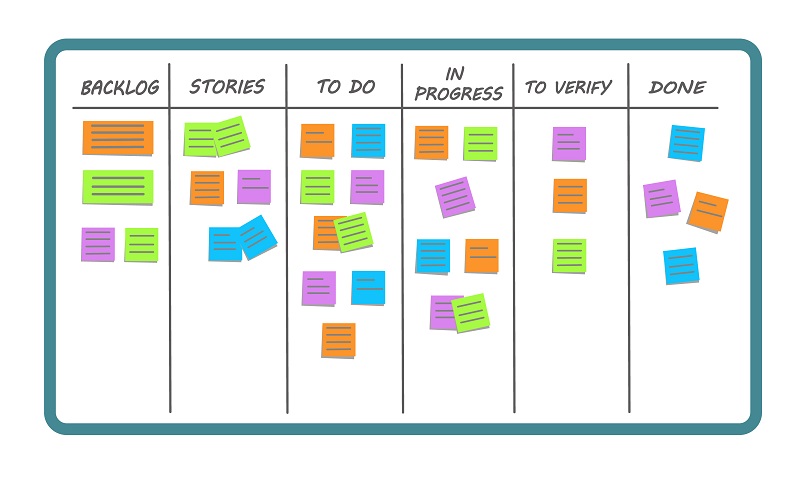
Agile stands as a beacon of adaptability and customer-centricity, signaling a shift from rigid, process-driven models to flexible, iterative approaches. Under the expansive umbrella of Agile, various methodologies and frameworks have sprouted, each catering to the specific needs and challenges of software projects. One such methodology that has gained significant traction is Kanban. Originating from the Japanese manufacturing sector, particularly Toyota's "just-in-time" production system, Kanban has evolved into a favored software development methodology globally. At its heart, Kanban is a visual system for managing work as it progresses through various stages.
The foundation of Kanban is the Kanban board, which is typically a digital or physical board divided into columns representing different stages of a process. Tasks, often written on cards, move from one column (or stage) to the next as they progress. This visual representation ensures transparency, allowing every team member to instantly assess the flow of tasks, identify bottlenecks, and understand current workloads.
Key principles of Kanban include:
Visualization: By representing tasks visually, team members can better comprehend the workflow and identify areas of inefficiency or delay.
Limiting Work in Progress (WIP): By setting a maximum number of tasks that can exist in a particular stage at any given time, teams can ensure that work progresses smoothly without overloading any part of the process.
Flow Management: Kanban emphasizes the continuous movement of tasks through stages. Monitoring and managing this flow helps to maintain a consistent and efficient pace of work.
Continuous Improvement: Regularly reviewing and adjusting the process is intrinsic to Kanban. The goal is to optimize workflow, reduce bottlenecks, and improve efficiency perpetually.
Feedback Loops: Regular feedback sessions ensure the team remains aligned, addresses concerns, and continuously learns from its experiences.
Distinguishing Features of Kanban:
Flexibility: Unlike methodologies like Scrum that have fixed-length iterations, Kanban is adaptable. As you mentioned, urgent tasks can be introduced into the workflow without waiting for a new cycle to begin.
Responsiveness: Kanban teams can quickly respond to changing priorities or unforeseen challenges due to their adaptive nature.
Reduced Lead Time: By optimizing flow and eliminating waste, Kanban often results in faster completion times for tasks.
Scalability: Kanban is versatile. It can be used for various purposes, from managing large-scale projects in the corporate world to organizing personal tasks or weekend family activities. Its visual nature can be a motivating factor, allowing individuals and teams to witness their accomplishments as tasks move from inception to completion.
In the realm of software development, Kanban has found particular favor among teams that need to maintain a steady and continuous flow of releases, address immediate concerns, and frequently reprioritize tasks based on evolving requirements or feedback.
Conclusion
Navigating the intricate world of software development can sometimes feel akin to charting a course through an expansive forest. With every methodology presenting its unique approach and set of principles, it's crucial for developers, managers, and stakeholders to understand the landscape to make informed decisions.
From the time-tested Waterfall model, rooted in its sequential approach, to the flexibility of the Agile methodologies that have been adapted to meet the ever-evolving needs of the digital world, software development models offer varied perspectives on how to bring a software project from concept to completion.
We delved deep into models like the V-shaped, Incremental, and Iterative models, appreciating the nuances that differentiate them. Yet, they all aim towards a singular goal: delivering functional, efficient, and user-centric software.
The Spiral model teaches us the importance of risk analysis, demonstrating that understanding potential pitfalls is as crucial as envisioning success. Meanwhile, methodologies under the Agile umbrella, such as Kanban, remind us that in an age of rapid technological advancement, adaptability is key.
However, it's essential to remember that no model is universally superior. Each has its strengths and drawbacks, and the most effective approach often depends on the specific project, the team's expertise, and the broader organizational goals.
As we conclude our journey through software development models, the overarching message is clear: understanding these models is not just about learning different development strategies. It's about appreciating the philosophy behind each approach, enabling us to tailor our methods to the unique demands of every software project. By doing so, we pave the way for innovative solutions, efficient workflows, and products that truly resonate with their intended users.
Exploring the Business Facets of Software Development
The business strategy behind software development is as crucial as the technology itself. At Mobile Reality, we provide a deep dive into the various business models, methodologies, and strategies that drive profitable and efficient software creation. Our comprehensive articles are designed to guide you through the complexities of the custom software development business:
These resources are crafted for those looking to refine their approach to building and managing software projects. Whether you’re contemplating the most effective development methodology, weighing the pros and cons of outsourcing, or deciding on the right pricing model, our insights can lead to informed decisions. Contact our team for a personalized consultation on software development business strategies. We’re here to help you navigate the path to success in the digital product landscape.




